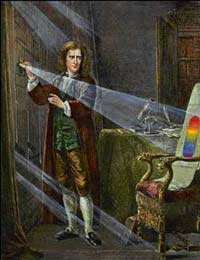Discover the origin of the rainbow

Isaac Newton
It has long been known that rainbows occur when the sun simultaneously shines with the rain. Rain drops change the white light of the sun into different colors.
Isaac Newton proved this in 1665 by placing a glass prism under a sun ray: he received the colors of the rainbow through diffraction, also demonstrating that white light is in fact The result of the mixing of the rainbow colors. Small droplets of rainwater act like small prisms and form a rainbow.
In order not to let any skepticism exist, Isaac Newton used another lens under the multicolored ray created by the first prism and he also received a new white ray - the second prism gathered colors to produce white light.
In 1668 Newton invented the telescope. This glass uses a concave mirror instead of one of the telescope's lenses. Today's telescopes are always structured on the same principle.
Learn about Isacc Newton scientist "the founder of classical physics"
- Rare rainbow moments appear in the world
- Strange rainbow twin
- 7 little things to know about rainbows
- Capture a rare, circular rainbow image
- Discover coral reefs that are as bright as a rainbow
- Rare 'rainbow rainbow' in the sky
- 5 consecutive rainbow glows in the sky of America
- The rare upside down rainbow rarely causes 'fever' in Britain
- Video: Record rainbow for nearly 9 hours in Taiwan, China
- Rare double rainbow
- Dragon hoses
- The double rainbow appears at the same aurora in the night sky
 Is the magnetic North Pole shift dangerous to humanity?
Is the magnetic North Pole shift dangerous to humanity? Washington legalizes the recycling of human bodies into fertilizer
Washington legalizes the recycling of human bodies into fertilizer Lightning stone - the mysterious guest
Lightning stone - the mysterious guest Stunned by the mysterious sunset, strange appearance
Stunned by the mysterious sunset, strange appearance